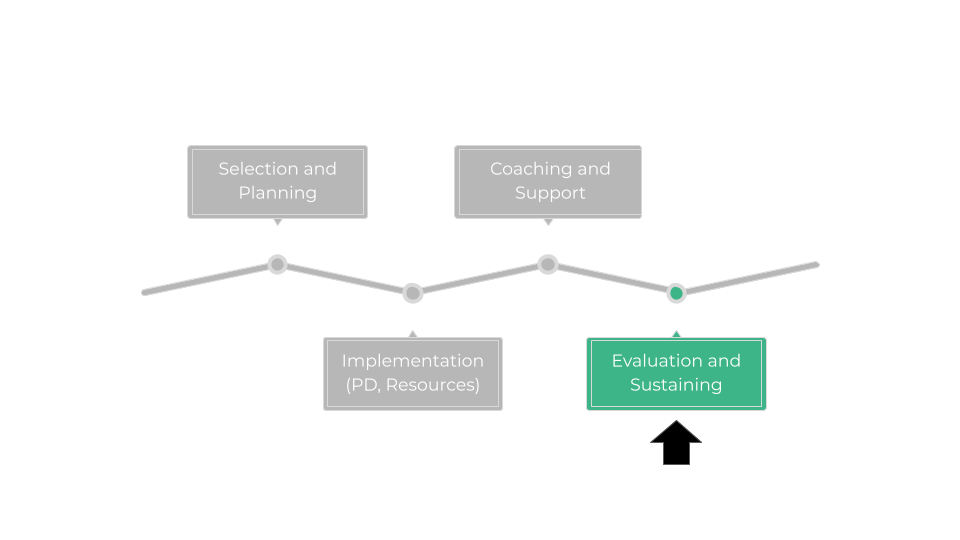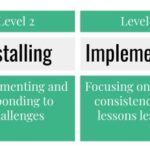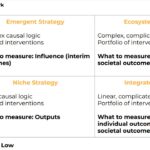A powerful resource for empowering teachers all stages of the implementation journey
The development and use of tools that define implementation integrity or maturity is often looked upon as a luxury or an afterthought in our school systems today.
As district leaders, we often think about developing tools that describe implementation only after we have already launched a key instructional initiative. We wait until teachers complete professional learning, attempt to implement in their classrooms, and report barriers and challenges. We then spend an unsustainable amount of time and resources supporting teachers to understand what “integrity of implementation” looks like in their contexts.
Or perhaps we believe that tools that define implementation are most useful for measuring implementation as an evaluative activity. We may develop implementation rubrics as a key measure of implementation integrity after an instructional initiative has been in place for some time. We may give instructional leaders access to these tools to conduct classroom walkthroughs, interpret the data, and then use the data to inform planning. However, we may not always wish to share these tools with teachers directly because we don’t want to provoke undue anxiety associated with the tools we use for “evaluative purposes.”
In addition to these situations, we may believe that it is the responsibility of the curriculum company or education service consultants to develop the tools to describe what implementation integrity looks like. And when they aren’t provided, we adopt the implicit messaging that such tools must not be necessary for effectively developing, supporting, and sustaining teachers throughout their implementation journey.
When we adopt these perspectives about measuring implementation, we fail to see how the tools that we typically use to measure implementation – self-report and observational rubrics – are in themselves useful for engaging teachers to transform their practice. While traditionally viewed as evaluative, implementation rubrics can also be transformative. They can serve as a key resource to support professional learning and teacher growth.
Implementation Rubrics – Not Just for Evaluation Anymore!
As is stated above, we tend to develop and communicate implementation rubrics late in the journey. We wait until the evaluation and sustainability phase before we use rubrics to evaluate implementation integrity or maturity.
This is when we usually think to use implementation rubrics:

Implementation rubrics are indeed quite useful for evaluating the extent to which teachers implement a curriculum or instructional initiative with integrity after the initiative has launched. But they are more than this. Implementation rubrics are educative. This means that they clearly communicate what implementation of a curricular or other instructional initiative looks like across a progression of practice so that all teachers and leaders have access to what implementation with integrity looks like in their contexts.
This is when we should think to use implementation rubrics:

To use implementation rubrics in a way that is not only evaluative but also transformative, we must develop them at project onset and utilize them as a key resource at each phase of the journey. We can use them:
- To clarify our theory of action about how the implementation should look over time,
- As a resource during our professional learning sessions to help teachers manage expectations and to communicate what the journey is expected to look like over time,
- As a self-assessment deployed across the system to collect baseline data to measure progress, as well as to understand the resources and needs teachers may require over time as they progress through the journey,
- As a collaborative self-assessment and talking point during professional learning community activities to inform ongoing coaching and feedback, and
- Also to evaluate the extent to which teachers demonstrate evidence of implementing with integrity over time in order to sustain the work.
The table below illustrates some key activities we can undertake to leverage the full potential of an implementation rubric:
| Phase | Key Uses of an Implementation Rubric |
| Selection and Planning | 1. Design an implementation rubric to help you clarify your theory of action. 2. Embed the rubric into a survey-based tool to conduct a system-wide self-assessment to gather baseline data for monitoring progress over time. 3. Use the rubric and the results from the baseline self-assessment to help you plan your professional learning sessions, implementation plan, and support resources. |
| Implementation (PD and Resources) | 1. Share the implementation rubric with teachers and instructional during professional learning sessions. 2. Align your coaching model to the rubric. 3. Adapt your rubric to use as an observation protocol that leaders can use to better understand how the curriculum or initiative looks in their classrooms. |
| Coaching and Support | 1. Adapt the rubric to serve as a collaborative assessment for teachers to complete during their professional learning communities. 2. Allow principals and coaches to use the observation data based on the rubric to provide feedback to teachers. 3. Use the rubric as a key talking-point for feedback during one-on-one coaching sessions. |
| Evaluation and Sustainability | 1. Administer additional iterations of the survey-based system-wide self-assessment to collect additional iterations of data to monitor progress over time. 2. Compute teacher-level implementation measures based on observation results in order to conduct an evaluation that relates implementation to student outcomes. |
Benefits
Using implementation rubrics at all stages of the journey offers many benefits. Implementation rubrics:
- Clarify what implementation may look like: This is a great way to communicate what integrity looks like for a majority of participants at each phase of their implementation maturity. Clearly illustrating for both teachers and leaders what the curriculum or instructional model should look like in the classroom is especially important in cases where an initiative requires a substantial change in teaching practice, or if there is not common agreement about implementation integrity within a district or school.
- Focus teacher and leader attention on the strategic initiatives: Implementation rubrics help focus attention, time, and resources on the things that are most likely to affect student outcomes, over other more supplemental or ad hoc tools that may distract or unintentionally inhibit student outcomes.
- Highlight gaps in alignment: Implementation rubrics serve as a tool for alignment between systemic curriculum initiatives, site-based instructional initiatives, and other structural supports. Well-written implementation rubrics incorporate both the systemic supports and classroom instructional model so that stakeholders can clearly evaluate if their ad hoc resources are in alignment with the intended approach.
- Create a common vocabulary: Operating from common terms and images creates a shared culture, goals, and values for leaders, teachers, and coaches throughout the system.
- Reduce time and expense: By getting clear about implementation at project onset will reduce unnecessary resources in repeated professional learning offerings or other structural supports down the road. Even in cases where districts learn, adapt, and modify their initiatives over time, implementation rubrics can help clarify the exact nature of these modifications as they get included in subsequent rubric versions. Publishing and communicating updated versions only reinforces the learning and demonstrates commitment to the work in the face of implementation dips.
- Empower meaningful self-assessment: Implementation rubrics enable teachers and leaders to self-assess and monitor their progress over time. Districts can deploy survey-based self-assessments to get a snapshot of teacher perceptions across the system, and schools can use collaborative self-assessments to describe their perceived level and identify next steps for planning.
By taking the time to develop implementation rubrics during the planning phase of a new curriculum or instructional initiative, teachers and leaders can better self-assess, transform, and sustain their key strategies that stand the best chance of changing the odds for teaching and learning.




